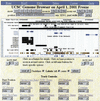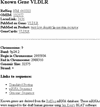The human genome browser at UCSC
- PMID: 12045153
- PMCID: PMC186604
- DOI: 10.1101/gr.229102
The human genome browser at UCSC
Abstract
As vertebrate genome sequences near completion and research refocuses to their analysis, the issue of effective genome annotation display becomes critical. A mature web tool for rapid and reliable display of any requested portion of the genome at any scale, together with several dozen aligned annotation tracks, is provided at http://genome.ucsc.edu. This browser displays assembly contigs and gaps, mRNA and expressed sequence tag alignments, multiple gene predictions, cross-species homologies, single nucleotide polymorphisms, sequence-tagged sites, radiation hybrid data, transposon repeats, and more as a stack of coregistered tracks. Text and sequence-based searches provide quick and precise access to any region of specific interest. Secondary links from individual features lead to sequence details and supplementary off-site databases. One-half of the annotation tracks are computed at the University of California, Santa Cruz from publicly available sequence data; collaborators worldwide provide the rest. Users can stably add their own custom tracks to the browser for educational or research purposes. The conceptual and technical framework of the browser, its underlying MYSQL database, and overall use are described. The web site currently serves over 50,000 pages per day to over 3000 different users.
Figures







Similar articles
-
The UCSC Genome Browser.Curr Protoc Bioinformatics. 2009 Dec;Chapter 1:Unit1.4. doi: 10.1002/0471250953.bi0104s28. Curr Protoc Bioinformatics. 2009. PMID: 19957273 Free PMC article.
-
The UCSC Genome Browser.Curr Protoc Bioinformatics. 2012 Dec;Chapter 1:1.4.1-1.4.33. doi: 10.1002/0471250953.bi0104s40. Curr Protoc Bioinformatics. 2012. PMID: 23255150
-
The UCSC Genome Browser.Curr Protoc Bioinformatics. 2007 Mar;Chapter 1:Unit 1.4. doi: 10.1002/0471250953.bi0104s17. Curr Protoc Bioinformatics. 2007. PMID: 18428780
-
UCSC genome browser tutorial.Genomics. 2008 Aug;92(2):75-84. doi: 10.1016/j.ygeno.2008.02.003. Epub 2008 Jun 2. Genomics. 2008. PMID: 18514479 Review.
-
The genome browser at UCSC for locating genes, and much more!Mol Biotechnol. 2008 Mar;38(3):269-75. doi: 10.1007/s12033-007-9019-2. Epub 2007 Dec 4. Mol Biotechnol. 2008. PMID: 18058261 Review.
Cited by
-
Liver Characterization of a Cohort of Alpha-1 Antitrypsin Deficiency Patients with and without Lung Disease.J Clin Transl Hepatol. 2024 Oct 28;12(10):845-856. doi: 10.14218/JCTH.2024.00201. Epub 2024 Sep 14. J Clin Transl Hepatol. 2024. PMID: 39440224 Free PMC article.
-
Gut microbiome impact on childhood allergic rhinitis and house dust mite IgE responses.Pediatr Res. 2024 Oct 21. doi: 10.1038/s41390-024-03645-y. Online ahead of print. Pediatr Res. 2024. PMID: 39433961
-
Genetic association between germline JAK2 polymorphisms and myeloproliferative neoplasms in Hong Kong Chinese population: a case-control study.BMC Genet. 2014 Dec 20;15:147. doi: 10.1186/s12863-014-0147-y. BMC Genet. 2014. PMID: 25526816 Free PMC article.
-
CCTop: An Intuitive, Flexible and Reliable CRISPR/Cas9 Target Prediction Tool.PLoS One. 2015 Apr 24;10(4):e0124633. doi: 10.1371/journal.pone.0124633. eCollection 2015. PLoS One. 2015. PMID: 25909470 Free PMC article.
-
Phylogenomics of strongylocentrotid sea urchins.BMC Evol Biol. 2013 Apr 23;13:88. doi: 10.1186/1471-2148-13-88. BMC Evol Biol. 2013. PMID: 23617542 Free PMC article.
References
-
- Birney E, Durbin R. Dynamite: A flexible code generating language for dynamic programming methods used in sequence comparison. Ismb. 1997;5:56–64. - PubMed
Publication types
MeSH terms
Substances
Grants and funding
LinkOut - more resources
Full Text Sources
Other Literature Sources
Molecular Biology Databases
Research Materials
